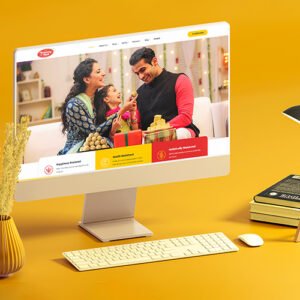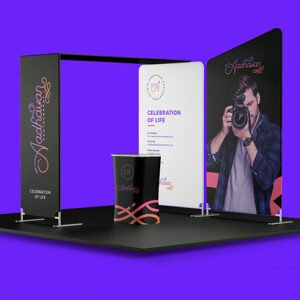Category: Uncategorised
Crafting Engaging Website Designs: User-Friendly Layouts and Navigation
Crafting engaging website designs involves creating user-friendly layouts and navigation that provide a seamless and intuitive browsing experience. Here are some key considerations for designing user-friendly layouts and navigation:
Clear and Consistent Layout:
Use a clear and consistent layout throughout the website to provide a familiar structure for users. Place important elements such as the logo, navigation menu, and key content in consistent locations across pages. Consistency enhances usability and helps users navigate the website more easily.
Intuitive Navigation:
Design intuitive navigation menus that are easy to find and use. Use standard navigation conventions, such as a horizontal menu at the top or a hamburger menu for mobile devices. Make sure navigation labels are descriptive and clearly indicate the content within each section or page. Avoid complex or hidden navigation elements that may confuse users.
Responsive Design:
Ensure your website design is responsive and adapts to different screen sizes and devices. A responsive design provides an optimal viewing experience on desktops, laptops, tablets, and mobile devices. Elements should resize and reposition appropriately to maintain readability and usability across devices.
Focused and Scannable Content:
Organize content in a way that allows users to quickly scan and find the information they need. Use headings, subheadings, bullet points, and short paragraphs to break up content into digestible chunks. Highlight important information or calls-to-action to draw attention. The use of whitespace helps improve readability and visual clarity.
User-Friendly Forms:
Design forms that are user-friendly and easy to complete. Use logical and clear labels, provide clear instructions, and minimize the number of required fields. Include real-time validation and informative error messages to help users complete forms accurately and efficiently.
Clear Call-to-Action (CTA) Placement:
Place clear and visually prominent call-to-action buttons strategically throughout the website. CTAs prompt users to take desired actions, such as signing up, purchasing, or contacting you. Ensure that CTAs are easily visible and distinguishable from other elements on the page, using color contrast, size, and styling.
Visual Hierarchy:
Establish a clear visual hierarchy in your designs to guide viewers’ attention and communicate messages effectively. Emphasize important elements using size, color, contrast, and placement. Create a logical flow that guides the viewer’s eye through the design.
User Testing and Feedback:
Conduct user testing to gather feedback on the usability and effectiveness of your website design. Observing how users navigate and interact with your website can provide valuable insights into areas that need improvement. Pay attention to user feedback and make iterative design changes based on their needs and preferences.
Performance Optimization:
Optimize your website’s performance to ensure fast loading times. Users expect websites to load quickly, and slow-loading pages can lead to frustration and high bounce rates. Optimize image sizes, minify code, use caching techniques, and leverage content delivery networks (CDNs) to improve performance.
By incorporating these principles into your website design, you can create engaging and user-friendly layouts with intuitive navigation. Prioritizing usability and user experience helps ensure that visitors can easily navigate, find information, and engage with your website, resulting in a positive and satisfying browsing experience.
Designing for Social Media: Optimizing Graphics for Online Platforms
Designing graphics for social media requires a thoughtful approach to ensure they are optimized for online platforms. Here are some essential tips to optimize your graphics for social media:
Understand Platform Requirements:
Each social media platform has specific image size and format requirements. Familiarize yourself with the recommended dimensions for profile pictures, cover photos, posts, stories, and ads on platforms like Facebook, Instagram, Twitter, LinkedIn, and others. Adhering to these specifications ensures that your graphics display properly and maintain their quality.
Visual Consistency:
Maintain consistent branding across your social media graphics. Use your brand colors, fonts, and logo consistently to create a cohesive and recognizable visual identity. Consistency helps reinforce your brand and improve audience recognition.
Attention-Grabbing Design:
Social media platforms are crowded, so make your graphics stand out. Use eye-catching visuals, vibrant colors, and unique design elements to capture users’ attention. Create compelling compositions that instantly communicate the message and engage viewers.
Clear and Readable Text:
Incorporate text in your graphics effectively. Use legible fonts, appropriate font sizes, and appropriate color contrasts to ensure readability. Keep the text concise, focusing on the key message. Consider the limited screen space on mobile devices when designing for social media.
Optimize for Mobile Viewing:
Since a significant portion of social media users access platforms on mobile devices, optimize your graphics for mobile viewing. Ensure that the design elements and text are clear and easily readable on smaller screens. Test your graphics across different devices and screen sizes to ensure they are responsive and visually appealing.
Visual Hierarchy:
Establish a clear visual hierarchy in your graphics to guide users’ attention. Use size, color, and contrast to emphasize important elements and create a structured layout. Make sure the most important information is prominent and easily distinguishable.
Simplify and Focus:
Keep your graphics simple and focused to convey the message effectively. Avoid clutter and excessive details that may distract or confuse viewers. Use clean and uncluttered designs that deliver the key information clearly and concisely.
Incorporate Branding Elements:
Integrate your brand identity into your social media graphics. Include your logo, brand colors, and other recognizable elements to strengthen brand awareness and consistency. Ensure that your graphics align with your overall brand image and messaging.
Test and Analyze:
Experiment with different graphic variations and monitor their performance. Utilize analytics tools provided by social media platforms to track engagement, reach, and other relevant metrics. Analyze the data to gain insights into what resonates best with your audience and refine your design approach accordingly.
By following these optimization tips, you can create visually appealing and effective graphics that enhance engagement, strengthen brand presence, and maximize the impact of your social media presence.
Exploring User Experience (UX) Design: Enhancing Digital Interactions
User Experience (UX) design is a discipline focused on creating meaningful and satisfying experiences for users when interacting with digital products or services. UX designers aim to understand user needs, behaviors, and motivations to design intuitive, user-friendly, and engaging digital experiences. Here’s an exploration of UX design and how it enhances digital interactions:
User Research:
UX design begins with user research, which involves gathering insights about the target audience. This can be done through methods such as interviews, surveys, observations, and usability testing. Understanding users’ goals, preferences, and pain points helps designers create experiences that meet their needs effectively.
User-Centered Design:
UX design follows a user-centered approach, putting the needs and expectations of users at the forefront. Design decisions are based on user research findings and user feedback. User personas and user journeys are created to gain a deeper understanding of user behavior and design experiences that align with their expectations.
Information Architecture:
Information architecture focuses on organizing and structuring content in a way that is intuitive and easily navigable. UX designers create sitemaps, hierarchical structures, and clear navigation systems to ensure that users can find information and perform tasks effortlessly. Well-structured information architecture enhances the overall usability of digital products.
Wireframing and Prototyping:
Wireframing is the process of creating low-fidelity, skeletal representations of digital interfaces. Prototyping involves building interactive models of the design to simulate user interactions and gather feedback. These techniques help UX designers visualize and test the functionality, flow, and usability of the digital product before it is fully developed.
Visual Design:
Visual design in UX focuses on creating visually appealing and consistent interfaces. It involves choosing appropriate colors, typography, icons, and other visual elements that align with the brand identity and user preferences. Visual design enhances the aesthetic appeal of digital products while supporting usability and clarity.
Usability Testing:
Usability testing involves observing and gathering feedback from users as they interact with the digital product. This testing helps identify areas of improvement, usability issues, and user pain points. By observing real users in action, UX designers can refine and enhance the design to create a more intuitive and seamless experience.
Interaction Design:
Interaction design focuses on designing meaningful and engaging interactions between users and digital products. UX designers carefully consider how users will interact with buttons, menus, forms, and other interface elements. The goal is to create interactions that are intuitive, responsive, and provide immediate feedback to users.
Mobile and Responsive Design:
With the increasing use of mobile devices, UX designers prioritize creating experiences that are responsive and optimized for different screen sizes and resolutions. Mobile UX design considers the unique constraints and behaviors associated with mobile devices, ensuring that users can access and interact with digital products seamlessly on various devices.
Continuous Iteration and Improvement:
UX design is an iterative process that involves gathering feedback, analyzing user behavior, and making improvements based on data and insights. UX designers continuously monitor user interactions, conduct usability tests, and iterate on the design to optimize the user experience over time.
By incorporating user-centered design principles, conducting thorough research, and continuously iterating on the design, UX designers create digital experiences that are intuitive, seamless, and enjoyable for users. The aim is to enhance user satisfaction, engagement, and achieve the business goals of the digital product or service.
Infographics: Telling Compelling Stories through Visual Data Representation
Infographics are powerful tools for presenting complex information and data in a visually compelling and easy-to-understand format. They combine text, visuals, and data representation techniques to tell a story, convey a message, or educate the audience. Here’s an exploration of how infographics can effectively communicate and tell compelling stories through visual data representation:
Data Selection and Simplification:
Infographics begin with the process of carefully selecting relevant data and information. The goal is to identify key insights and simplify complex data sets into digestible chunks. By focusing on the most important and impactful data points, infographics avoid overwhelming the audience and enhance clarity.
Visual Hierarchy and Story Flow:
Infographics should have a clear visual hierarchy that guides the audience through the information. Start with an attention-grabbing headline or introduction, followed by a logical flow of content. Use visual cues such as size, color, and placement to emphasize key points and create a narrative structure that keeps the audience engaged.
Visual Representation of Data:
Infographics employ various techniques to visually represent data. Bar charts, line graphs, pie charts, and diagrams help illustrate relationships, trends, comparisons, or proportions effectively. Icons, illustrations, or images can complement the data representation, making it more relatable and engaging. The visual elements should be clear, accurate, and aligned with the data being presented.
Use of Color and Typography:
Color and typography play a crucial role in enhancing the visual appeal and readability of infographics. Consistent color schemes help organize information and create visual coherence. Use color strategically to highlight important data points or create visual associations. Typography choices should be legible and aligned with the overall design aesthetic, ensuring easy comprehension of the text.
Simplicity and Clarity:
Infographics should strive for simplicity and clarity in both design and content. Use concise and straightforward language to explain complex concepts. Avoid cluttered layouts or excessive text, focusing on presenting the most important information. White space can be utilized effectively to create visual breathing room and improve readability.
Storytelling Elements:
Infographics can incorporate storytelling elements to engage the audience. Introduce a narrative structure with a clear beginning, middle, and end. Use visual storytelling techniques, such as sequential graphics or illustrations, to guide the audience through the information. Storytelling adds context, emotion, and relatability to the data, making it more memorable.
Balance between Visuals and Text:
Infographics strike a balance between visuals and text to effectively convey the message. Visuals should enhance and support the information provided in the text, avoiding redundancy. Use text sparingly, focusing on key insights, labels, and explanations that complement the visuals. Utilize concise headlines, subheadings, and bullet points to improve scannability.
Design Consistency and Branding:
Infographics should adhere to consistent design principles and align with the brand identity. Use brand colors, typography, and visual elements to create a cohesive visual experience. Consistency in design builds recognition and establishes a sense of professionalism.
Responsiveness and Accessibility:
With the prevalence of digital platforms, infographics should be responsive and adaptable to different screen sizes and devices. Consider accessibility guidelines to ensure that the infographic can be accessed and understood by a diverse audience. Use alternative text for images, provide text versions, and ensure color contrast for readability.
Infographics have the potential to captivate audiences and communicate complex information effectively. By combining data representation techniques, storytelling elements, and thoughtful design choices, infographics can present compelling stories that inform, educate, and engage viewers in a visually stimulating manner.
Understanding Grid Systems: Organizing Layouts with Precision
Grid systems are essential tools in graphic design and layout organization. They provide a framework for arranging elements on a page or screen with precision, consistency, and visual harmony. Grids help designers achieve balanced compositions, improve readability, and establish a sense of order in their designs. Here’s a closer look at understanding and utilizing grid systems effectively:
Grid Basics:
A grid consists of a series of horizontal and vertical intersecting lines that divide a layout into columns, rows, and modules. The lines create a structure that acts as a guide for placing content and determining spatial relationships. Grids can be simple, with evenly spaced columns, or more complex with variations in column widths and spacing.
Establishing Grid Structure:
Before starting a design, define the grid structure based on the project’s requirements. Determine the number of columns, their width, and the gutter space between them. Consider the content type, hierarchy, and desired visual impact when establishing the grid. Grids can be symmetrical or asymmetrical, depending on the design goals.
Consistency and Alignment:
Grids facilitate consistency and alignment across different design elements. Elements can be aligned to specific grid lines or intersections, ensuring a cohesive and organized layout. Alignment helps establish visual relationships, improve readability, and create a sense of order. Consistent spacing and alignment contribute to a professional and polished design.
Modular Grids:
Modular grids divide the layout into modules or sections of various sizes. This approach allows for flexibility and dynamic compositions. Content can be placed within modules, allowing for versatility and adapting to different types of content or screen sizes. Modular grids are commonly used in editorial design, web design, and responsive layouts.
Hierarchical Structure:
Grids help establish a hierarchical structure by defining the placement and size of different elements. Key elements, such as headlines or focal points, can span multiple columns or modules, while secondary elements occupy smaller sections. Establishing a clear hierarchy guides the viewer’s attention and enhances readability and understanding.
Breaking the Grid:
While grids provide structure, they can also be intentionally broken to create visual interest and impact. Breaking the grid means deviating from the established layout and introducing elements that span multiple columns, overlap, or disrupt the regular grid structure. This technique can be used strategically to draw attention, create emphasis, or add a sense of dynamism to the design.
Grids in Digital Design:
Grid systems are equally important in digital design, including web and mobile interfaces. Responsive grids allow for fluid layouts that adapt to different screen sizes. Grid frameworks, such as Bootstrap, provide pre-defined grids and components that assist in designing responsive interfaces. Grids ensure consistency and optimal use of space across various devices.
Grid Adaptation:
Grids are flexible tools that can adapt to different design needs. They can be adjusted and modified to accommodate various design elements and content types. Designers may choose to create different grid systems for specific sections of a project or adapt existing grids to suit specific requirements. Experimentation and iteration are key to finding the most effective grid structure for a design.
By utilizing grid systems, designers can create well-organized, visually appealing layouts that communicate effectively and improve user experience. Grids provide a foundation for designers to bring harmony, structure, and precision to their designs, resulting in more cohesive and aesthetically pleasing visual compositions.
Designing Effective Packaging: Strategies for Visual Product Communication
Designing effective packaging is crucial for product communication and capturing the attention of consumers. Packaging serves as a visual representation of the product and plays a significant role in influencing purchasing decisions. Here are some strategies for creating visually compelling and communicative packaging:
Clear Brand Identity:
Packaging should reflect the brand’s identity and be consistent with its overall visual branding. Incorporate the brand’s logo, colors, typography, and other visual elements to create a cohesive and recognizable packaging design. Consistency helps build brand recognition and fosters a sense of trust and familiarity with consumers.
Product Differentiation:
Packaging should highlight the unique features and benefits of the product, setting it apart from competitors. Consider the product’s positioning and target audience when designing packaging that communicates its value proposition effectively. Use visual cues, such as images or graphics, to showcase key product attributes and create a memorable impression.
Visual Hierarchy:
Design packaging with a clear visual hierarchy that guides consumers’ attention. The most important information, such as the product name, should be prominent and easily readable. Use size, color, and typography to differentiate between essential elements like product details, benefits, and usage instructions. Ensure that the hierarchy supports a quick and intuitive understanding of the product.
Storytelling:
Packaging can tell a story that resonates with consumers and connects them emotionally to the product. Incorporate narratives, imagery, or illustrations that evoke the brand’s values or the product’s origin, ingredients, or production process. Storytelling adds depth and engagement to the packaging, creating a memorable experience for consumers.
Simplicity and Clarity:
Keep the packaging design simple and uncluttered, allowing for easy comprehension. Avoid overwhelming consumers with excessive text or design elements. Use clear and concise messaging to convey essential information about the product. Emphasize the key selling points while maintaining a visually pleasing and balanced design.
Authenticity and Transparency:
In today’s consumer landscape, authenticity and transparency are highly valued. Packaging should accurately represent the product and align with its quality and ingredients. Use transparent packaging materials when possible to showcase the product itself, fostering trust and giving consumers a glimpse of what they are purchasing.
User-Friendly Design:
Packaging should be user-friendly and convenient to use. Consider the ergonomics of opening, handling, and storing the product. Incorporate functional design elements such as easy-to-read labels, clear instructions, and resealable features when appropriate. A positive user experience with the packaging can enhance overall satisfaction with the product.
Sustainability:
Design packaging with sustainability in mind. Consumers are increasingly concerned about the environmental impact of packaging materials. Use eco-friendly materials, minimize excess packaging, and incorporate recyclable or biodegradable components when possible. Highlight the brand’s commitment to sustainability, as it can resonate with environmentally conscious consumers.
Test and Iterate:
Before finalizing the packaging design, gather feedback and conduct consumer testing. This can help identify potential improvements and ensure that the packaging effectively communicates the desired message. Iteration based on user feedback can lead to a more impactful and consumer-centric packaging design.
Effective packaging design combines aesthetics, functionality, and strategic communication to create a compelling visual experience. By incorporating these strategies, brands can enhance their product’s shelf appeal, differentiate themselves from competitors, and engage consumers through visual storytelling and clear communication.
Exploring the Art of Visual Branding: Designing Memorable Brand Identities
Visual branding is the process of creating a distinct and memorable identity for a brand through visual elements such as logos, colors, typography, and imagery. It plays a crucial role in shaping the perception of a brand and connecting with the target audience. Here’s an exploration of the art of visual branding and designing memorable brand identities:
Brand Strategy:
Before diving into visual design, it’s important to establish a solid brand strategy. This involves defining the brand’s values, personality, target audience, and positioning. Understanding the brand’s essence and unique selling propositions helps in creating a visual identity that accurately represents the brand.
Logo Design:
The logo is the centerpiece of a brand’s visual identity. It should be a unique and recognizable symbol that captures the essence of the brand. The designer explores various concepts, typography options, and visual elements to create a logo that conveys the brand’s personality and resonates with the target audience.
Color Palette:
Colors evoke emotions and create visual associations. Choosing a color palette that aligns with the brand’s personality and appeals to the target audience is crucial. Designers consider color psychology, cultural connotations, and brand differentiation when selecting colors that will be used consistently across various brand materials.
Typography Selection:
Typography plays a significant role in visual branding. Different fonts evoke different moods and can convey the brand’s personality. Designers select typefaces that are legible, unique, and align with the brand’s identity. Combining multiple fonts for different purposes (such as headlines and body text) adds depth and versatility to the brand’s visual language.
Visual Elements and Imagery:
Consistent visual elements and imagery contribute to a strong brand identity. These elements could include patterns, textures, icons, or illustrations that reinforce the brand’s personality and evoke its desired associations. Carefully selected imagery can enhance brand storytelling and create a visual language that is uniquely identifiable.
Brand Guidelines:
Once the visual elements are established, brand guidelines are created to maintain consistency across all brand touchpoints. These guidelines include rules for logo usage, color codes, typography specifications, and guidelines for visual applications. Consistent use of these guidelines helps in building brand recognition and a cohesive brand experience.
Application Across Touchpoints:
A memorable brand identity extends beyond just a logo. It should be consistently applied across various touchpoints such as stationery, packaging, websites, social media profiles, advertisements, and more. Designers ensure that the brand’s visual identity translates seamlessly across different mediums, maintaining its impact and recognition.
Evolving and Adaptation:
Brand identities are not static and may need to evolve over time to stay relevant. As the brand grows or market trends change, designers may revisit and refresh the brand’s visual elements while maintaining its core essence. However, it’s important to balance consistency with adaptability to ensure that the brand remains recognizable.
From Concept to Creation: The Art of Graphic Design
Graphic design is a creative process that involves conceptualizing, planning, and creating visual content using various elements such as typography, images, colors, and layout. It is a form of visual communication that combines artistic skills, aesthetics, and technical expertise to convey messages, ideas, or information effectively.
Here is a step-by-step overview of the graphic design process, from concept to creation:
Research and Understanding:
Before starting any design project, it’s essential to gather information and understand the client’s requirements, target audience, and project goals. Researching the industry, competitors, and current design trends can also provide valuable insights.
Concept Development:
Based on the gathered information, the graphic designer starts brainstorming ideas and developing concepts. This stage involves sketching, doodling, and exploring different creative directions to find a compelling concept that aligns with the project objectives.
Initial Design:
Once a concept is selected, the designer begins translating it into a visual form. They create rough drafts or digital mockups to present initial design ideas. These drafts serve as a starting point for further refinement and feedback.
Typography and Layout:
Typography plays a crucial role in graphic design. Selecting appropriate fonts, sizes, and styles that complement the concept is essential. Designers also focus on creating an effective layout that organizes elements and guides the viewer’s eye through the design.
Color and Imagery:
Choosing the right color scheme is crucial as it evokes specific emotions and conveys the intended message. Graphic designers carefully select colors that harmonize with the design and evoke the desired response. Imagery, such as photographs or illustrations, may also be incorporated to enhance the visual impact.
Iteration and Feedback:
At this stage, the initial design is reviewed, and feedback is collected from the client or stakeholders. The designer incorporates the feedback, makes necessary revisions, and refines the design. This process may go through several iterations until the final design is approved..
Finalization:
Once the design is refined and approved, the graphic designer prepares the final artwork. This involves ensuring the design is in the appropriate file format, resolution, and color mode suitable for its intended use, such as print or digital media.
Delivery and Implementation:
The final design is delivered to the client or relevant parties. If it’s for print, the designer may work with a printer to ensure accurate reproduction. In the case of digital media, the designer may assist with implementing the design on websites, social media platforms, or other digital channels.
Throughout the graphic design process, it’s crucial for designers to maintain effective communication with clients, collaborate with team members (if applicable), and stay up-to-date with industry trends and software tools to create visually compelling and impactful designs.
Unleashing Creativity: Exploring Graphic Design Techniques
Exploring different graphic design techniques can help unleash creativity and bring fresh perspectives to your design work. Here are several techniques you can try to enhance your creative process:
Mood Boards:
Create mood boards by collecting images, colors, textures, typography, and other visual elements that inspire you. Mood boards can serve as a visual reference and help set the tone and direction for your design projects. They are great for exploring different visual styles and gathering ideas.
Typography Experiments:
Typography is a powerful design element. Push the boundaries of typography by experimenting with custom lettering, playing with different font combinations, or manipulating typefaces. Try unconventional layouts, kerning, tracking, and leading to create unique typographic treatments.
Collage and Mixed Media:
Combine different visual elements, such as photographs, illustrations, textures, and found objects, to create collages or mixed-media designs. Experiment with layering, overlapping, and blending techniques to add depth and visual interest to your compositions.
Hand-Drawn Illustrations:
Incorporate hand-drawn elements and illustrations into your designs. Whether it’s sketching, doodling, or painting, working by hand adds a personal and organic touch. Scan or digitize your hand-drawn artwork and integrate it with digital design tools for further manipulation.
Experiment with Color:
Color has a significant impact on design. Step outside your comfort zone and explore unconventional color palettes. Experiment with hue, saturation, contrast, and color combinations to evoke specific moods or create unexpected visual effects. Tools like Adobe Color can assist in generating harmonious color schemes.
Play with Perspectives:
Challenge traditional design conventions by experimenting with unusual perspectives and viewpoints. Explore different angles, rotations, and distortions to create dynamic and visually engaging compositions. This technique can add a sense of depth and intrigue to your designs.
Negative Space:
Embrace the power of negative space by using it intentionally in your designs. Play with the relationship between positive and negative space to create clever and thought-provoking visuals. Negative space can help communicate hidden messages or create optical illusions.
Minimalism:
Simplify your designs by embracing minimalism. Use clean lines, ample white space, and limited color palettes to create visually striking and impactful designs. Focus on essential elements and remove any unnecessary clutter. Minimalism can often convey a sense of elegance and sophistication.
Grid Systems:
Utilize grid systems to create structured and organized layouts. Grids can help establish hierarchy, maintain consistency, and provide a solid foundation for your design. Experiment with different grid structures, such as modular grids or asymmetric layouts, to add visual interest.
Visual Storytelling:
Explore ways to tell stories visually through your designs. Consider how you can use images, illustrations, typography, and composition to communicate narratives or convey emotions. Experiment with sequential art, storyboarding, or creating visual narratives through a series of designs. Embrace feedback as an opportunity to grow and refine your skills.
Explore ways to tell stories visually through your designs. Consider how you can use images, illustrations, typography, and composition to communicate narratives or convey emotions. Experiment with sequential art, storyboarding, or creating visual narratives through a series of designs. Embrace feedback as an opportunity to grow and refine your skills.








